Back Row, from left to right: Deborah Aird, Michael Reach, and Brian Glanz. Front row, from left to right: Teresa Wakefield, Paula Mister, Brian Glanz, Romina Alcabasa, and Dr. Karen Carroll. Not pictured: Ame’ Maters.
Blood cultures are important diagnostic tests performed in microbiology laboratories. In addition to adequate blood volume, it is imperative that proper skin/line antisepsis occur prior to collection to minimize blood culture contamination. Numerous studies show blood culture contamination leads to excess length of stay, increased laboratory charges (20%), increased parenteral antibiotic charges (39%), and excess overall costs. The College of American Pathologists determined the national benchmark for blood culture contamination rates among inpatient adult populations to be <3.0% of total blood cultures obtained. No benchmark has been set for Emergency Departments or Outpatient Clinics.
The Microbiology Lab performed an organism search by location for blood cultures each month from January 2006-June 2007 to establish baseline data. We refined the blood culture positivity report to determine the contamination rate (%) by unit using a manual process. A monthly electronic report was then developed with Pathology Data Systems to determine the rate of contamination by unit using an automated process. The blood culture collection guidelines were revised and incorporated into the Institution’s blood culture policy. Units whose rates exceed the threshold are contacted and in-services are provided. We coordinated educational in-services with the Emergency Department, as well as other units. Emergency Department rates are reported and tracked separately.
Since the project’s conception in October 2007, blood culture contamination rates have continued to decline and remain below the national benchmark (≤3.0%) and exceeded the target (≤2.5%) set for adult inpatient units. Contamination rates averaged 1.4% YTD in FY10. A dedicated vascular access team and a core group of skilled nursing staff in the Emergency Department who are responsive to the monthly reports have ensured continued success of this initiative.
Brian Glanz, Michael Reach, Ame’ Maters, Deborah Aird, Paula Mister, Romina Alcabasa, Teresa Wakefield, and Karen Carroll, M.D.
Medical Microbiology Division
Johns Hopkins Hospital
